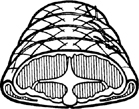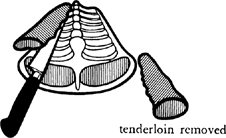Mastering the Art of French Cooking, Volume 2 (89 page)
Read Mastering the Art of French Cooking, Volume 2 Online
Authors: Julia Child

Shave off all but ⅛-inch layer of covering fat on the topside, and make a criss cross of bias cuts ½ inch apart in the surface, going just down to the flesh. These will help the meat to cook evenly, and make attractive decorations on the crisp, roasted surface later on. |
|
Sprinkle underside with salt, pepper, and a big pinch of thyme or rosemary, fold flanks against backbone to cover tenderloin strips, and tie circumference of saddle in 3 or more places with white string. If you are not to cook the saddle now, wrap and refrigerate it.
(*)
AHEAD-OF-TIME NOTE
: Saddle may be prepared to this point a day before roasting.

SELLE D’AGNEAU RÔTIE
[Roast Saddle of Lamb]
A plain roast saddle of lamb is so good in itself that you need go into no elaborations, although one or two are suggested at the end of this recipe. A classic accompaniment is that crusty, buttery mound of sliced potatoes,
pommes Anna
, or one of the two variations following it, and either braised lettuce or braised endives. Another suggestion would be eggplant, such as the
gratin provençal
with its tomatoes and cheese; you would then need only an excellent loaf of homemade French bread. A fine, red Bordeaux-Médoc would be your best choice of wine.
For 4 to 6 people
1)
Preparations for roasting
A saddle of lamb trimmed, seasoned, and tied according to the preceding directions (4 to 5 lbs. trimmed weight)
A heavy, shallow baking dish just large enough to hold the saddle comfortably
4 Tb melted butter in a pan and a basting brush
½ cup each, sliced carrots and onions
2 large cloves garlic, unpeeled
Optional but recommended: a meat thermometer
Preheat oven to 475 degrees for Step 2. Set saddle right side up in the roasting pan and paint exposed ends of meat with melted butter, reserving rest for later. If you are using a meat thermometer, insert it at a long, slanting angle into the thickest part of one of the loin strips. Be sure point of thermometer reaches middle of meat and does not touch bone. Prepare the vegetables and garlic, and reserve in a bowl for Step 2.
2)
Roasting—about 45 minutes—oven preheated to 450 degrees
ROASTING START
. Set lamb in upper-middle level of preheated oven for 15 minutes.
15-
MINUTE MARK
. Turn thermostat down to 425 degrees. Working quickly, baste 2 ends of saddle with melted butter, and strew the vegetables and garlic around the meat. Baste vegetables with fat in baking dish, or with butter.
22-
MINUTE MARK
. Rapidly baste meat and vegetables again, with fat in dish.
30-
MINUTE MARK
. Baste again rapidly. If vegetables are blackening, turn thermostat down to 400 degrees.
37-
MINUTE MARK
. Baste again. If you are using a meat thermometer, it should be at 125 to 130 degrees for rare meat. Meat should feel springy rather than squashy and raw, and the first juices should be exuding from the meat into the pan. Roast a few minutes longer if necessary; if you wish your meat medium rare and pink rather than red, roast to 140 degrees. (Note that if meat was chilled when it went into the oven, it may take a few minutes longer to roast. A heavier saddle will take 50 to 55 minutes in all. Baste every 4 to 5 minutes when roasting longer.)
WHEN DONE
. Turn off oven and set lamb on a platter near outside end of open oven door; a rest of 10 to 15 minutes before carving will permit juices to retreat back into meat tissues. Discard trussing strings after the rest period. Meanwhile, make the sauce, next step.
3)
The sauce
⅓ cup dry white wine or dry white French vermouth
1 cup beef stock or bouillon
Optional: 1 medium tomato, chopped (not peeled)
Salt and pepper
A sieve
A small saucepan
Spoon all but a tablespoon of fat out of roasting dish, pour in wine and stock, and add optional tomato. Set over high heat and boil, scraping up coagulated roasting juices with a wooden spoon; mash cooking vegetables into liquid as it boils. Reduce liquid by about half, correct seasoning, strain into saucepan, and keep warm. You will have only enough sauce to moisten each serving of meat.
(*)
AHEAD-OF-TIME NOTE
: If you can control the heat, you may leave the finished lamb in a warming oven of no more than 120 degrees for at least half an hour. With your sauce all made, you can then serve immediately.
4)
Carving and serving
CARVING AT THE TABLE
. If you wish to carve at the table you may follow the system of many
maîtres d’hôtel
, which is to make long, thin slices on each side, parallel to the backbone. (The first slice, which shaves off the fat, is not served.) Then turn the saddle upside down, cut off the flanks, and reserve for second helpings; cut out the tenderloin strips, and slice into crosswise pieces.
CARVING IN THE KITCHEN AND REASSEMBLING
. This works out nicely, and the carved pieces are replaced on the saddle bone. Although you may cut the long thin slices described in the preceding paragraph, we suggest cutting across the grain for better eating texture. Provide yourself with a long, very sharp knife, a fork, and a carving board; heat oven to 475 degrees for a brief warm-up after the reassembly, and carve rapidly, as follows:
Turn saddle upside down and slice off the flanks. Cutting down parallel against the backbone and then following its outward curve, |
|




